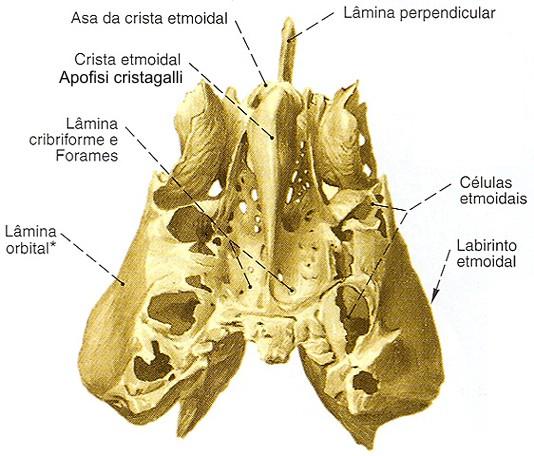Lessico
Etmoide
Apofisi cristagalli
Cresta di gallo dell'etmoide
Etmoide deriva dal greco ėthmoeidės = simile a un filtro, a un colino, detto ėthmós. Č un osso impari e mediano che concorre a formare la base del cranio, i turbinati e le fosse nasali. Ha forma irregolare e consta fondamentalmente di tre lamine, una mediana verticale - detta apofisi cristagalli - che prende contatto con l'apice della grande falce encefalica, e una lamina orizzontale che si incrocia superiormente con la prima, nonché da due masse a forma di parallelepipedo che si staccano dalla lamina orizzontale detta anche membrana cribrosa o lamina cribriforme perché presenta una serie di piccoli fori, attraversati da rami del nervo olfattorio (il I paio di nervi cranici). Anche le due masse laterali presentano escavazioni anfrattuose, i seni etmoidali (detti anche cellule labirintiche etmoidali), che comunicano con le fosse nasali.
La terza lamina, inferiore, č anch'essa perpendicolare: articolandosi con la cartilagine del setto e col vomere entra a far parte della costituzione del setto nasale; la sua parte anterosuperiore č in continuitą con l'osso frontale (per mezzo della spina nasale).

The ethmoid bone (from Greek ėthmós, "sieve") is a bone in the skull that separates the nasal cavity from the brain. As such, it is located at the roof of the nose, between the two orbits. The cubical bone is lightweight due to a spongy construction. The ethmoid bone is one of the bones that makes up the orbit of the eye.
The ethmoid articulates with fifteen bones: four of the neurocranium the frontal, and the sphenoid (at the sphenoidal body and at the sphenoidal conchae), eleven of the viscerocranium two nasal bones, two maxillae, two lacrimals, two palatines, two inferior nasal conchae, and the vomer.
Role in magnetoception: some birds and other migratory animals have deposits of biological magnetite in their ethmoid bones which allow them to sense the direction of the Earth's magnetic field. Humans have a similar magnetite deposit, but it is believed to be vestigial.